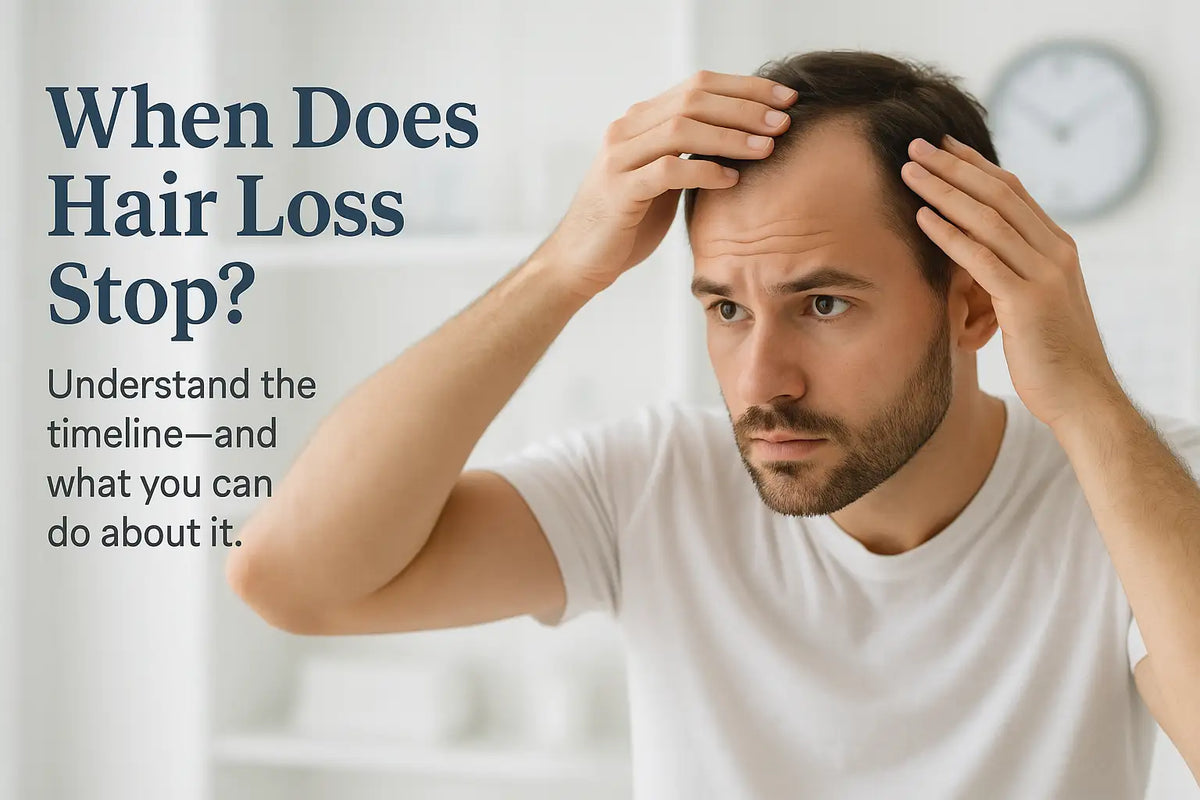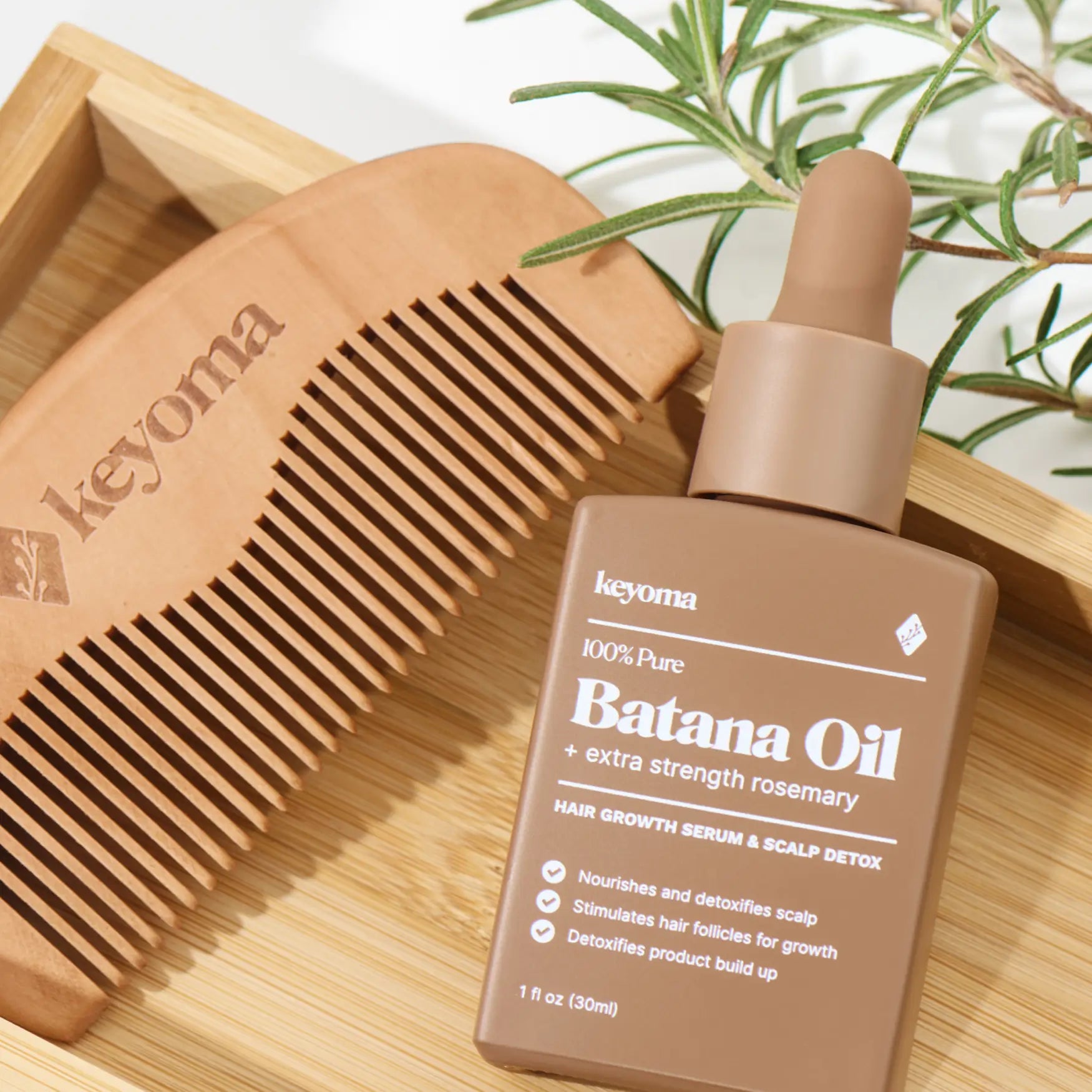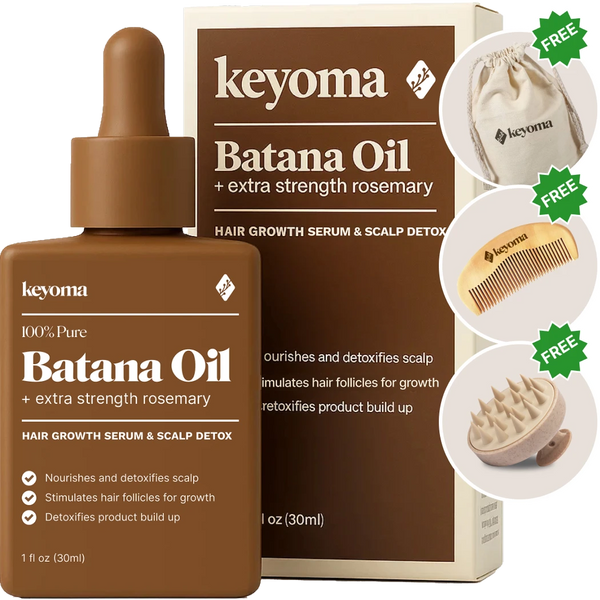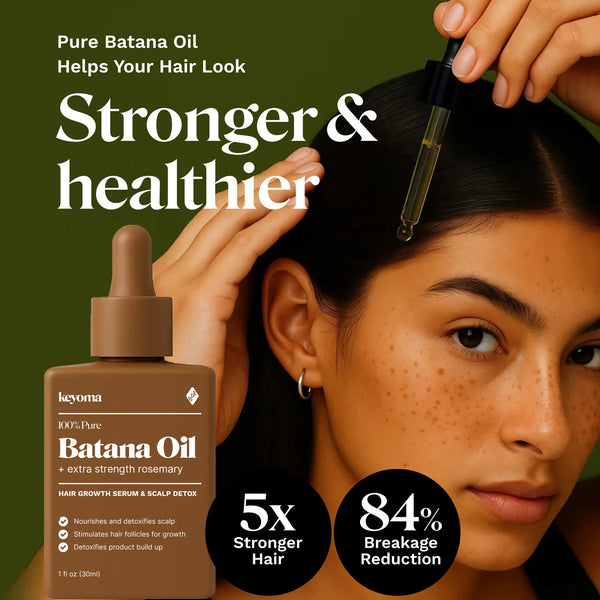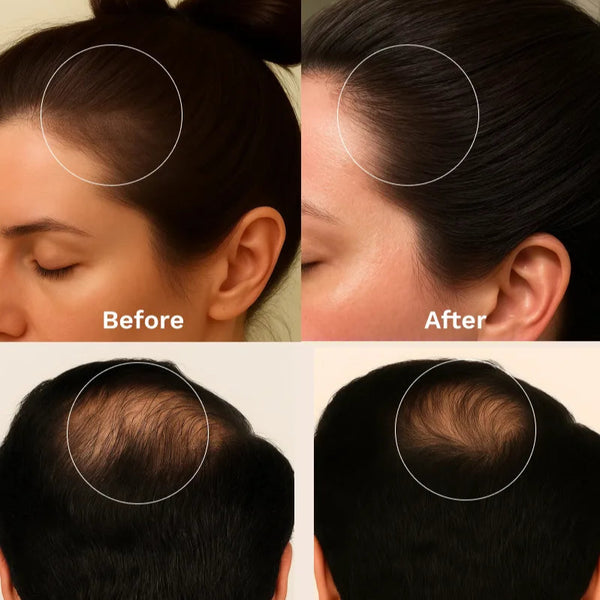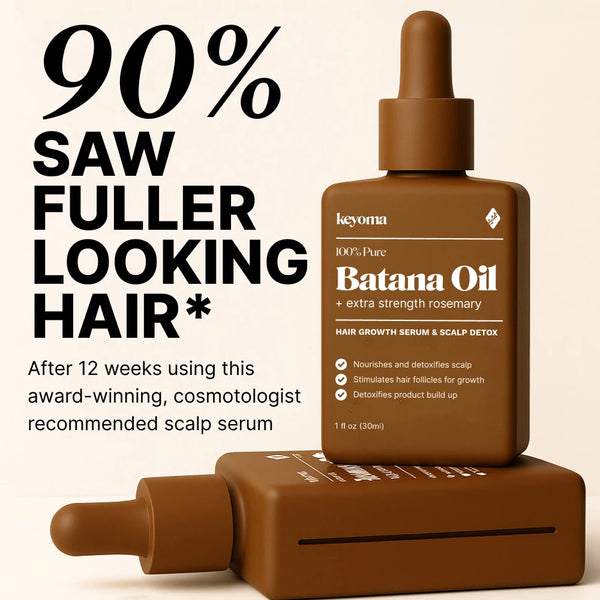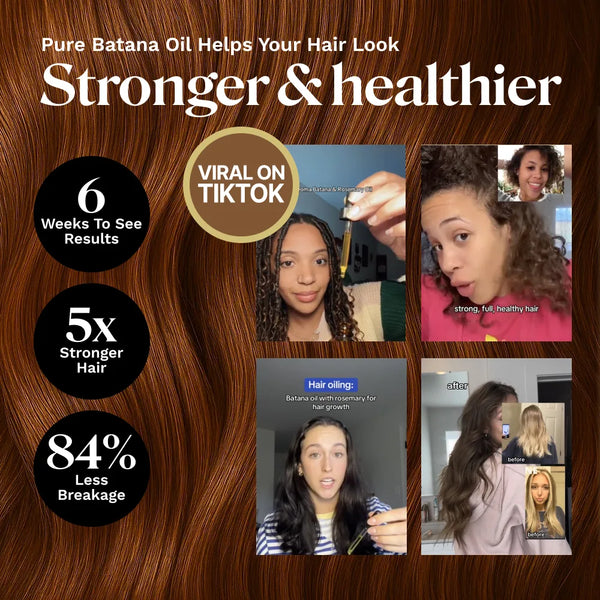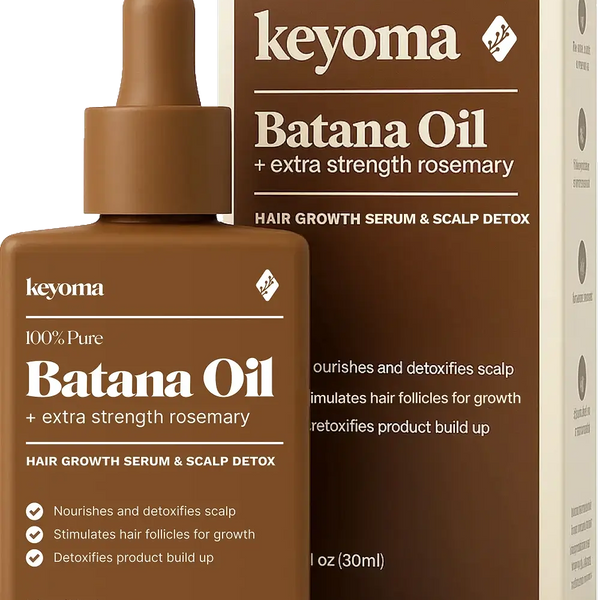In this article
Noticing early signs of hair loss can be unsettling. Whether you’re seeing extra strands near the shower drain, on your pillow, or spotting a change in scalp coverage or hair thickness, it’s important to take the issue seriously.
As you begin tackling the problem early on, you might start to wonder if hair loss is something you’ll deal with for life. Does it continue at the same pace once it begins, or does the body eventually slow the process down?
It’s a fair question—and one that concerns both men and women. The answers offer insight into how hair loss progresses and how we can take long-term steps to manage it effectively.
Let’s explore whether hair loss naturally slows with age and what you can do to stay ahead of it.
When Hair Loss Starts and Why It Happens
To figure out if hair loss actually slows down or stops as you age, it helps to look at when it usually starts and what drives it in the first place. Everyone’s experience is a little different, but research has revealed some clear patterns and frequent causes.

Here is a quick overview of when hair loss tends to happen and the main factors that influence shedding at different stages of life.
After Puberty: First Signs of Male Hair Loss
Hair loss in men can begin surprisingly early, even during the teenage years. Once puberty kicks in and male hormones start changing the body, some young men may notice early signs of thinning hair. In fact, research shows that higher levels of testosterone—and especially its byproduct DHT—can start affecting hair as early as age 15.
While early-onset hair loss is not the norm, the mechanism behind it is often the same. Studies suggest that some individuals have more active androgen receptors, which can disrupt the natural hair growth cycle. That disruption speeds up the development of androgenetic alopecia, even at a young age.
Hair Loss in Your Late 20s and 30s
Hair thinning becomes much more common for men in their late 20s and 30s, with around one in three experiencing noticeable loss during this time. By this point, testosterone levels have peaked and gradually declined, while more of the hormone is converted into DHT—a process influenced by years of hormonal shifts and physical stress.
Although more men start seeing signs of pattern balding around age 30, this stage also presents a strong opportunity for intervention. Since hair loss is still moderate, many men respond well to treatments and lifestyle changes that can slow or even reverse the progression.
The key takeaway: men in their late 20s and 30s are more likely to develop hair loss, but they also have a solid chance of preserving their hair if they act early and follow a consistent care routine. No matter your age, early detection and proper treatment give you the best shot at maintaining your hair.
For women, this age range can also mark the beginning of hair thinning, often due to styling habits or the onset of hormonal shifts that trigger female pattern hair loss.
Hair Loss in Your 40s and 50s
Hair loss in men tends to follow a fairly steady pattern. On average, the risk goes up by about 10 percent with each passing decade. So by the time a man reaches his 40s, there is around a 40 percent chance he will see noticeable hair loss. In the 50s, the odds jumped to nearly fifty-fifty.
But it is not just male pattern baldness that causes changes. As men age, hair naturally becomes thinner, finer, and often starts to lose its original color—even if the hairline has not moved. This happens with or without androgenetic alopecia.
And this is where awareness really matters. Men should watch for more than just the obvious signs like receding hairlines or bald patches. Subtle changes in texture, fullness, or scalp visibility can also signal that the aging process is starting to affect the hair.
Why Do Some Men Go Bald While Others Don’t?
For most men, genetics play a major role in determining whether they’ll lose their hair and how that loss will appear. A quick glance at your family history—especially the hairlines of close relatives—can give you a strong clue about your own hair’s future.
Hormones also contribute by attacking and shrinking hair follicles, which leads to gradual thinning. As men age, hair follicles often become more sensitive to these hormonal changes. In addition, certain health conditions, prescription drugs, and daily habits can speed up the hair loss process.
In some cases, men can slow or even stop hair loss by targeting the root cause. Treating medical issues, changing medications with a doctor’s guidance, or adjusting lifestyle choices may help stop a receding hairline.
The early signs of hair loss often confuse men, especially when the cause isn’t obvious. If you’re unsure whether your hairline is receding, compare recent photos with older ones when you had fuller hair. If photos aren’t available, ask someone close to you—like a family member or long-time friend—for honest feedback. Their input might not be what you hope to hear, but it can help you decide whether it’s time to take action or monitor the changes more closely.
Does Hair Loss Stop on Its Own or Keep Going?
Once hair loss starts, it might seem like it will only get worse. But in reality, the rate and severity of hair loss vary from person to person and rarely follow a straight path.
When evaluating your own situation, keep these important points in mind:
For Most Men, Hair Loss Doesn’t Stop Without Help
The reality is that once androgenetic alopecia begins, hair loss usually continues. However, the speed and severity of the process vary widely depending on genetics, lifestyle habits, and available treatments.
In most cases, hair loss unfolds over 15 to 25 years, gradually progressing through the Norwood stages until only hair around the sides and back of the head remains. That said, some men may notice the shedding slows or stabilizes around age 35.
Top hair restoration specialists recognize that hair loss isn’t the same for everyone. Differences in pace, intensity, and visibility all play a role. The good news is that early detection and timely action can make a big difference—there’s still plenty of room for improvement if you start early and stick to a tailored plan.
Will Hair Grow Back After You Go Bald?
So, here’s the real question: Can hair grow back naturally after balding?
The answer is—it depends. If the hair follicles are still alive but inactive, there’s a chance for regrowth. Early-stage hair loss, such as gradual thinning, often responds well to treatment. But if the follicles have been dormant for a long time—especially in completely bald areas—they're likely permanently inactive.
The American Academy of Dermatology notes that only some men experience regrowth with medication. If you're hoping to recover lost hair, acting quickly gives you the best chance. Starting treatment early can help preserve vulnerable follicles and improve your odds of bringing them back.
Take Control of Hair Loss With Keyoma’s Batana Oils
It’s possible for hair to grow back, but it depends on several factors—what’s causing the loss, how much hair you’ve lost, and how quickly you take action. Natural methods may help slow down shedding or support early regrowth, but they typically won’t restore hair in bald areas caused by male pattern baldness.
If your follicles are still active, there’s a chance your hair can grow back on its own. However, many types of hair loss are long-term and may need medical treatments to see real improvement.
That said, natural solutions can still play a role in supporting scalp health and maintaining strong, healthy hair.
Looking for a natural way to nourish your scalp and protect your strands?
Try Keyoma Batana Oil—a powerful, nutrient-rich formula designed to support hair strength, improve scalp condition, and complement your hair restoration efforts.
Featured Product
100% Pure Batana Oil + Rosemary
↓Best Batana Oil to Buy↓
1 Month
Subscribe & Save
- 30-day supply delivered monthly $35
- 30% off for life $6
- Free haircare essentials kit $33
- Free custom wooden comb $10
- Free scalp massager $15
- Free eco-friendly travel bag $8
- 30-Day Money Back Guarantee
- Free Shipping
- Online portal for easy cancel, skip, or pause.
1 Month One Time Purchase

- 30-day supply $50
- 30% off for life $6
- Free haircare essentials kit $33
- Free custom wooden comb $10
- Free scalp massager $15
- Free eco-friendly travel bag $8

